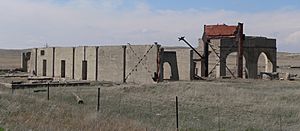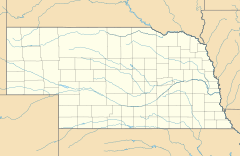Antioch, Nebraska facts for kids
Quick facts for kids
Antioch, Nebraska
|
|
|---|---|

Ruins of potash plant near Antioch, April 2011
|
|
| Country | United States |
| State | Nebraska |
| County | Sheridan |
| Elevation | 3,881 ft (1,183 m) |
| Time zone | UTC-6 ([MST]) |
| • Summer (DST) | MST |
| Area code(s) | 308 |
| GNIS feature ID | 834979 |
Antioch is a ghost town in Sheridan County, Nebraska, United States. It's located about 15 miles (24 km) east of Alliance on Nebraska Highway 2. This town was once known as "the potash capital of Nebraska." It got its name from a town called Antioch, Ohio. Today, only a few houses remain, with fewer than 25 people living there.
Contents
A Town Built on Potash
Antioch is found in the Sandhills region of western Nebraska. This area doesn't have many people living in it. Before the United States joined World War I, Antioch was a very small place. It had just one school, a church, and a store.
What is Potash?
In 1917, scientists at the University of Nebraska found a way to get potash from the water of special lakes. These lakes are called alkaline lakes and are common in the Sandhills. Potash is a mineral used to make things like fertilizer for plants, Epsom Salts, and soda. Before the war, most potash came from Germany.
The Potash Boom
When World War I started, it became very hard to get potash from Germany. This made the price of potash skyrocket! It went from about $8-$10 per ton to an amazing $150 per ton.
Antioch was close to many of these alkaline lakes. Because of this, five large potash factories were built there. These factories were named American, Nebraska, Alliance, National, and Western. They became major suppliers of potash during the war.
A City Grows Fast
With the new factories came lots of jobs. By the spring of 1918, Antioch had grown into a small city. More than 5,000 people lived there! The potash from Antioch helped the war effort by being used in important products.
The land where the factories were built belonged to the state. Some people wondered why the government leased the land to private companies without a public auction. To explain this, the Nebraska Secretary of State said they leased the land quickly to avoid delays. They claimed the country needed the potash for "munitions" (war supplies). While potash wasn't actually used in munitions, people generally accepted this explanation because of the urgent wartime situation.
The End of the Boom
After the war ended in 1921, Germany and France started trading with the United States again. Potash from these countries was much cheaper to make than Nebraska potash. This made it impossible for the American factories to compete.
The factories in Antioch closed down right away. Their machines were sold for scrap metal. The factory buildings were taken apart for their materials. Even the houses built for the workers were torn down or moved away. Only the foundations of the factories and some larger houses were left behind. Today, Antioch is a quiet place with fewer than 25 residents.
In 1979, the remains of Antioch's potash plants were added to the National Register of Historic Places. This means they are important historical sites. You can find a historical marker west of what's left of Antioch. It tells the story of the factories and this amazing boomtown.




